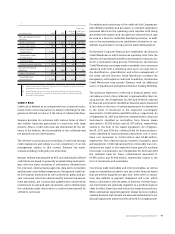Siemens 2015 Annual Report Download - page 97
Download and view the complete annual report
Please find page 97 of the 2015 Siemens annual report below. You can navigate through the pages in the report by either clicking on the pages listed below, or by using the keyword search tool below to find specific information within the annual report.Consolidated Financial Statements
(expenses), net resulted in a gain (loss) of € million and
€() million, respectively, in fiscal and ; the related
swap agreements resulted in a gain (loss) of €() million and
€ million, respectively. Net cash receipts and payments relat-
ing to such interest rate swap agreements are recorded as inter-
est expenses.
The Company had interest rate swap contracts to pay variable
rates of interest of an average of . % and . % as of Septem-
ber , and , respectively and received fixed rates of
interest (average rate of . % and . %, as of September ,
and , respectively). The notional amount of indebted-
ness hedged as of September , and was € , mil-
lion and € , million, respectively. This changed % and
% of the Company’s underlying notes and bonds from fixed
interest rates into variable interest rates as of September ,
and , respectively. The notional amounts of these
contracts mature at varying dates based on the maturity of the
underlying hedged items. The net fair value of interest rate
swap contracts (excluding accrued interest) used to hedge in-
debtedness as of September , and was € mil-
lion and € million, respectively.
NOTE 24 Financial risk management
Increasing market fluctuations may result in significant earn-
ings and cash flow volatility risk for Siemens. The Company’s
operating business as well as its investment and financing ac-
tivities are affected particularly by changes in foreign exchange
rates, interest rates and equity prices. In order to optimize the
allocation of the financial resources across the Siemens seg-
ments and entities, as well as to achieve its aims, Siemens iden-
tifies, analyzes and manages the associated market risks. The
Company seeks to manage and control these risks primarily
through its regular operating and financing activities, and uses
derivative financial instruments when deemed appropriate.
In order to quantify market risks Siemens has implemented a
system based on parametric variance-covariance Value at Risk
(VaR), which is also used for internal management of the Cor-
porate Treasury activities. The VaR figures are calculated based
on historical volatilities and correlations of various risk factors,
a ten day holding period, and a . % confidence level.
Actual results that are included in the Consolidated Statements
of Income or Consolidated Statements of Comprehensive In-
come may differ substantially from VaR figures due to funda-
mental conceptual differences. While the Consolidated State-
ments of Income and Consolidated Statements of Comprehensive
Income are prepared in accordance with IFRS, the VaR figures are
the output of a model with a purely financial perspective and
represent the potential financial loss which will not be exceeded
within ten days with a probability of . %. Although VaR is an
important tool for measuring market risk, the assumptions on
which the model is based give rise to some limitations including
the following. A ten day holding period assumes that it is possi-
ble to dispose of the underlying positions within this period.
This may not be valid during continuing periods of illiquidity
markets. A . % confidence level means, that there is a . %
statistical probability that losses could exceed the calculated
VaR. The use of historical data as a basis for estimating the sta-
tistic behavior of the relevant markets and finally determining
the possible range of the future outcomes on the basis of this
statistic behavior may not always cover all possible scenarios,
especially those of an exceptional nature.
Any market sensitive instruments, including equity and inter-
est bearing investments, that our Company’s pension plans
hold are not included in the following quantitative and qualita-
tive disclosures.
FOREIGN CURRENCY EXCHANGE RATE RISK
Transaction risk
Each Siemens unit conducting businesses with international
counterparties leading to future cash flows denominated in a
currency other than its functional currency is exposed to risks
from changes in foreign currency exchange rates. In the ordi-
nary course of business Siemens units are exposed to foreign
currency exchange rate fluctuations, particularly between the
U. S. dollar and the euro. Foreign currency exchange rate expo-
sure is partly balanced by purchasing of goods, commodities
and services in the respective currencies as well as production
activities and other contributions along the value chain in the
local markets.
Operating units (Industrial business and SFS) are prohibited
from borrowing or investing in foreign currencies on a specula-
tive basis. Intercompany financing or investments of operating
units are preferably carried out in their functional currency or
on a hedged basis.
According to the company policy each Siemens unit is respon-
sible for recording, assessing and monitoring its foreign
currency transaction exposure. The net foreign currency posi-
tion of each unit serves as a central performance measure and
has to be hedged within a band of at least % but no more
than %.
Generally, the operating units conclude their hedging activities
internally with Corporate Treasury. By applying a cost-optimiz-
ing portfolio approach Corporate Treasury itself hedges foreign
currency exchange rate risks with external counterparties and
limits them Company-wide.
























